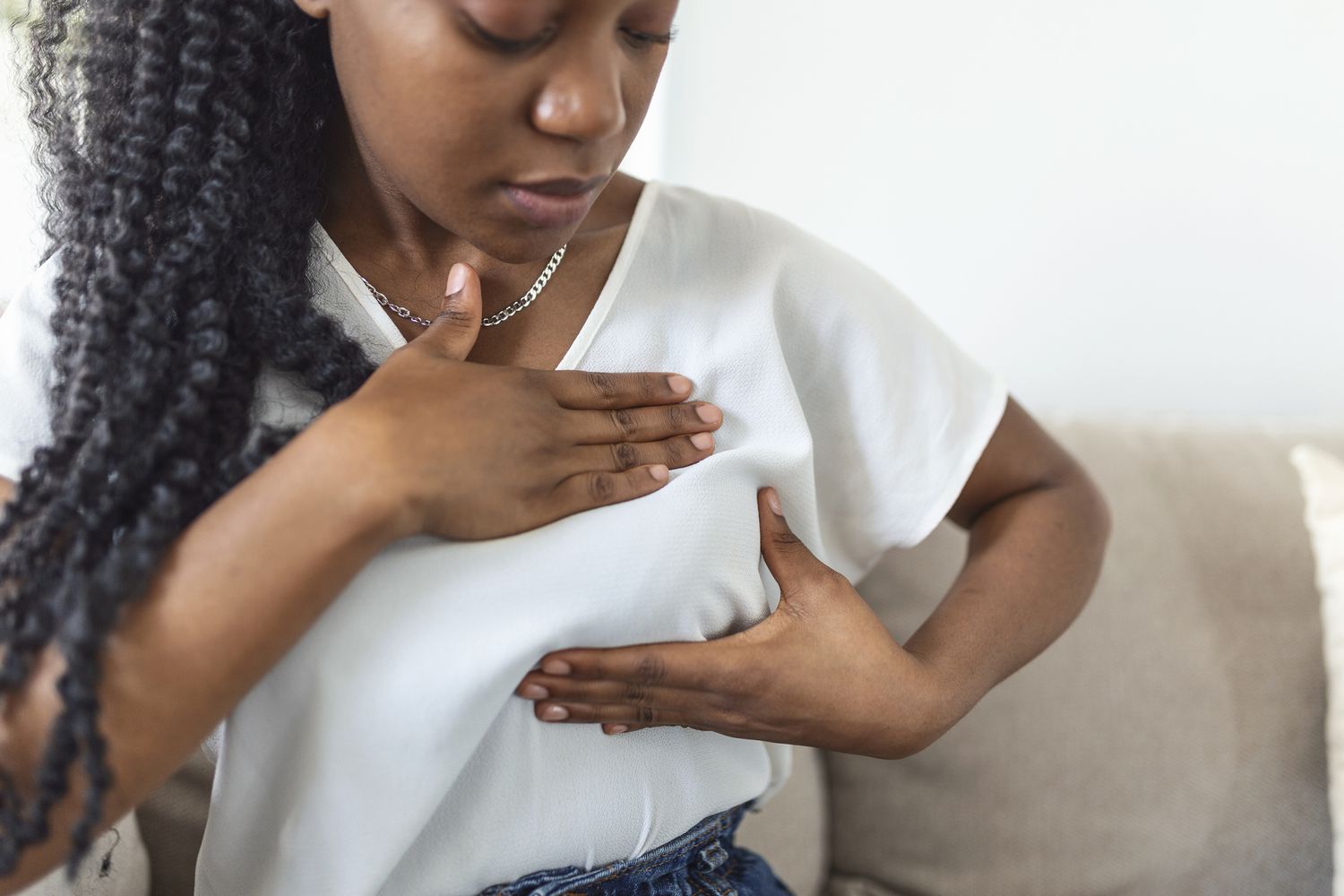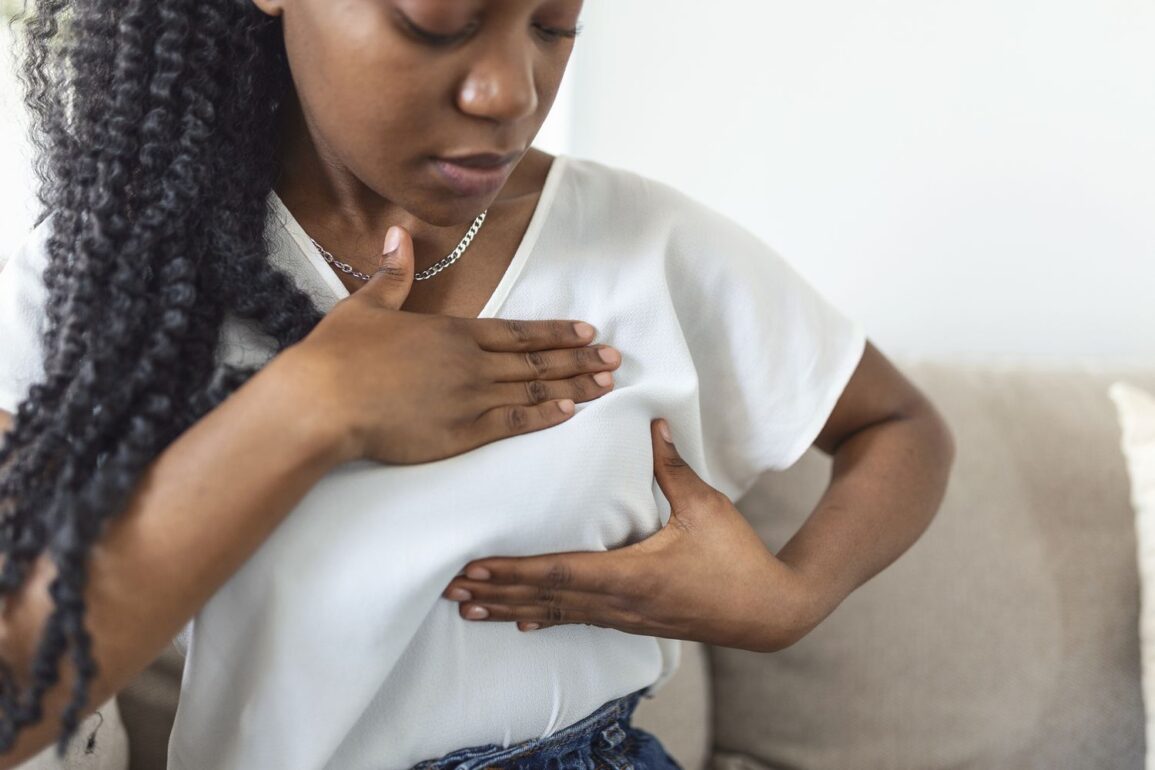
Black women have the lowest breast cancer survival rate, regardless of the stage at diagnosis. And while breast cancer occurs less often (about 5% less than in White women), it is 38% more likely to prove fatal among Black women, according to 2024 data from the American Cancer Society. It’s not just women: Black males have the highest breast cancer death rate among males, too.
The most common first symptom is a breast lump. Let your healthcare provider know right away, even though many possible causes are benign (not cancer). Early diagnosis and treatment can affect the outcome, and breast cancer often affects younger Black women who may not consider breast cancer a likely cause. Barriers to care continue for Black women, so it’s important to be an informed advocate on breast cancer.
Illustration by Julie Bang for Verywell Health
A Note on Gender and Sex Terminology
Verywell Health acknowledges that sex and gender are related concepts, but they are not the same.
- Sex refers to biology: chromosomal makeup, hormones, and anatomy. People are most often assigned male or female at birth based on their external anatomy; some people do not fit into that sex binary and are intersex.
- Gender describes a person’s internal sense of self as a woman, man, nonbinary person, or another gender, and the associated social and cultural ideas about roles, behaviors, expressions, and characteristics.
Research studies sometimes don’t use the terminology in this way. For example, terms that describe gender (“woman,” “man”) may be used when terms for sex (“female,” “male”) are more appropriate.
To reflect our sources accurately, this article uses terms like “female,” “male,” “woman,” and “man” as the sources use them.
Black Women and Breast Cancer: The Facts
For Black women, the rate of 26.8 deaths per 100,000 is higher than any ethnic group. Younger Black women are especially at risk. The incidence of breast cancer in females younger than age 50 has been rising.
Researchers continue to explore reasons for the disparities that affect Black women, including:
- Barriers to healthcare access and breast cancer screenings, like mammograms
- Disparities in diagnosis that affect how far cancer already has advanced at the time of diagnosis. This can change treatment options and affect prognosis. Black women are also most likely to be diagnosed with larger and more clinically advanced tumors.
- Factors like social determinants to genetics and tumor biology influence disparities, such as the higher risk of triple-negative breast cancer in Black women, but they don’t explain them entirely.
- Subtype of cancer, with aggressive and treatment-resistant triple-negative breast cancer occurring more often in Black women.
- Social and environmental factors. A 2024 study suggests that social and environmental factors may influence genes involved in estrogen receptor ER+ cancers and their recurrence. Effects in Black people may be due to features of structural racism.
Overall, the breast cancer fatality rate peaked in 1989 and has dropped 44% since then, primarily due to advances in diagnosis and treatment. Yet the positive effects have not equally benefited all groups.
Types of Breast Cancer
Two types of invasive breast cancer disproportionately impact Black women: triple-negative breast cancer and inflammatory breast cancer (IBC). With these types:
- Triple-negative breast cancer is estrogen-receptor-negative, progesterone-receptor-negative, and HER2-negative. These classifications note the presence or absence of hormone receptors (hormone receptor status). If the receptors are not present, cancer is much more difficult to treat because hormone-related medications aren’t effective.
- Inflammatory breast cancer is a rare, highly aggressive invasive breast cancer with atypical symptoms. Lumps, for example, don’t occur and it might not show up on mammogram. IBC only accounts for 1% to 5% of all breast cancers, but Black women are 70% more likely than others to be diagnosed with IBC. It’s already metastasized (spread) in about a third of diagnosed cases. A 2021 study found IBC affects 4.5 Black women out of 100,000 but just 2.6 White women.
Dimpling of the skin, which is sometimes called peau d’orange (French for “the skin of an orange”), is a classic sign of inflammatory breast cancer. IBC develops rapidly, blocking lymphatic vessels in the breast, resulting in red, swollen, and tender breasts.
Statistics show that the five-year survival rate for Black women with IBC is lower than it is for White women regardless of the cancer’s hormone receptor status and the patient’s age.
Other types of breast cancer include:
- DCIS refers to a precursor breast cancer called ductal carcinoma in situ (DCIS). DCIS means the cells that line the milk ducts have become cancerous, but those cells have not yet invaded the surrounding tissues. DCIS is often discovered on mammograms.
- HR+/HER2- is the most common, highly treatable subtype. It accounts for 59% of cases in Black women, but that’s far lower than other ethnic groups. It’s 73% in White women.
- HR-/HER2+ is the least common type, occurring in just 3% to 6% of all cases.
HR+/HER2- Subtype
HR+/HER2- subtype is the most common. When treated before it has spread, it can have a 100% five-year survival rate. Yet Black women with this diagnosis have worse outcomes than any other ethnic group. Researchers say race (not other variables) is the reason and studies need to include more people of color to find out why.
Symptoms
Breast cancer usually does not have any symptoms in its early stages when the tumor is small and hard to notice. This stage is also when breast cancer will be easiest to treat, which is why screening mammograms are important. The U.S. Preventive Services Task Force recommends mammograms every other year from ages 40 to 74.
Some changes to your breast tissue can be a sign of cancer and are something that you should not ignore. These include:
- New lump in the breast or underarm (armpit)
- Thickening or swelling of part of the breast
- Irritation, puckering, or dimpling of breast skin
- Redness or itchy, flaky skin in the nipple area or the breast
- Pulling in of the nipple or pain in the nipple area
- Nipple discharge other than breast milk, including blood
- Change in the size or the shape of the breast
- Pain in any area of the breast
Inflammatory breast cancer can present with symptoms that mimic an infection. If you experience painful swelling, darkening, or redness in the breast, contact a healthcare provider immediately to avoid life-threatening complications.
Causes
Certain breast cancer risk factors like smoking, alcohol use, or being diagnosed as overweight or obese may be modified, while factors like older age or being female cannot. Some known risk factors for breast cancer also include:
- Genetic mutations (most notably BRCA 1 and BRCA 2 mutations)
- Family history of breast cancer
- Reproductive history that includes early periods (before 12 years old) or late menopause (after 55)
- Breasts with higher amounts of connective tissue compared to fat (dense breasts) which can mask cancers
- Personal history of breast cancer
- Exposure to radiation (including radiation therapy for another condition, like Hodgkin’s lymphoma)
- Taking some forms of hormone replacement therapy for five or more years
Environmental exposures may be a factor. One area of interest is stricter regulation of the ingredients used in cosmetic products, such as hair dyes and straighteners.
Some preliminary research has shown that there might be a link between these products and breast cancer risk. The marketing campaigns often target Black women.
Racial Disparities
Black women are least likely to receive an early-stage diagnosis than counterparts from other racial and ethnic groups. According to the American Cancer Society, 68% of White women are diagnosed with breast cancer when it is at an early stage compared to only 58% of Black women.
Factors for why Black women may not receive the care they need:
- Lack of insurance
- Lack of access to providers
- Medical mistrust and misinformation
Other factors may include age, income, lack of transportation or child care, and immigration status.
Promising recent data suggest that 73% of Black women had a mammogram screening within the two-year study period. Yet studies suggest they are less likely to have high-quality screenings and follow-up care when results are concerning.
The few studies that have assessed the racial disparities in breast cancer diagnosis only looked at system delays—which means that delays in the diagnosis and treatment of breast cancer in Black people may be underreported.
Patient delay is a term used to describe the time that elapses from symptom development or self-detection to medical consultation, whereas system delay describes the time that elapses from consultation to diagnosis.
Diagnosis
Breast cancer is the most diagnosed cancer in Black women, and since 2019 has become the most fatal type of cancer in Black women, surpassing even lung cancer.
Black women are more likely to have more aggressive, treatment-resistant forms of breast cancer like triple-negative and inflammatory breast cancer (IBC). They are also diagnosed at a younger age.
Breast cancer is typically detected in one of three scenarios:
- During screening (including a mammogram)
- Incidentally on a physical exam before symptoms have developed
- After you notice a lump
A healthcare provider will take a detailed health history and do a clinical breast exam. They might also order additional tests—like a mammogram, ultrasound, or magnetic resonance imaging (MRI)—to figure out what the breast lump is.
Questions Your Healthcare Provider May Ask
- When did you first notice the lump?
- Is the lump in one breast or both breasts?
- Can you feel the lump if you change positions (such as going from lying down to standing, or sitting to standing)?
- What does the lump feel like (hard, tender, firm)?
- Have you noticed any areas of swelling near the breast or armpit?
- Is the lump fixed in one place or does it move?
- Does the lump correlate with your menstrual cycle?
- Have you experienced associated symptoms like breast pain, fever, or unexplained weight loss?
- Do you have a personal or family history of cancer (especially anyone in the family who has been found to have either a BRCA1 or BRCA2 mutation)?
Most lumps that are identified during a self-exam and assessed on a mammogram turn out to be noncancerous. If cancer is suspected, a biopsy will need to be done.
The two most common biopsy types are a fine-needle biopsy and a larger core-needle biopsy, although some conditions require a surgical biopsy. The type of biopsy used will depend on the size and location of the mass, as well as patient factors, patient preferences, and resources.
Treatment
Breast cancer treatment will depend on factors that include the stage of the cancer, its subtype, and your overall health history. It may require chemotherapy, radiation, and/or surgery.
Local treatment options include surgical removal of breast tissue and radiation therapy. These are the most commonly performed procedures in breast cancer patients and are often used together.
Depending on the type of breast cancer and how advanced it is, you may need additional treatments that kill cancer throughout the body (systemic treatment).
Examples of systemic treatments for breast cancer include:
These treatments can reach cancer cells by being ingested by mouth (orally) or put directly in the bloodstream (intravenously).
To advocate for your own care, be sure to:
- Prepare for your appointments with questions for your healthcare providers and work together on a treatment plan
- Tap into support groups and networks, and enlist the support of family and friends
- Be open to new therapies and clinical trials. If your healthcare provider does not bring up this information, ask about it.
Cancer Care Team
A team of healthcare professionals is needed to manage your cancer treatment. An oncologist (a specialist in cancer treatment) will lead the care team and manage your care. They will share pertinent information with your primary care provider. A plastic surgeon might also be brought into your care team if you are interested in breast reconstruction surgery after having a partial or full mastectomy.
Summary
Black women face a high risk of a breast cancer diagnosis, especially some of the most aggressive cancer subtypes. Breast cancer in Black women is more often fatal than in other ethnic groups.
Black women also face barriers to care. The persistence of racial disparities in breast cancer is primarily caused by a lack of access to health care, but even when policies are implemented that improve mammography screening, insurance availability disparities still exist.
Biased healthcare delivery, medical mistrust, and targeted marketing of potentially dangerous cosmetic problems are also barriers that Black women face. More inclusive research is needed to bridge the gaps in understanding the race-associated differences that exist.



